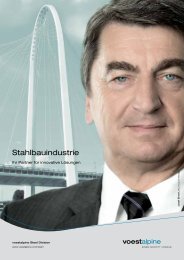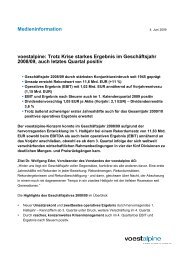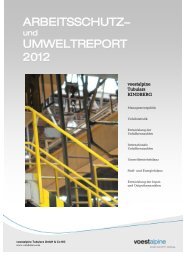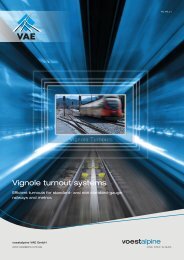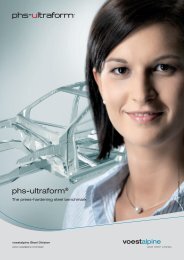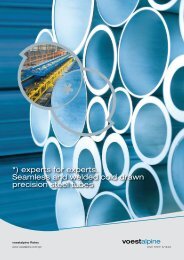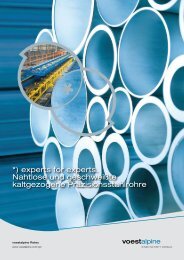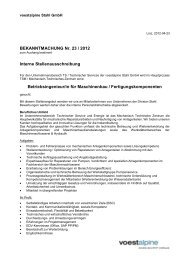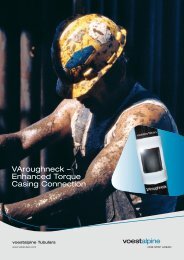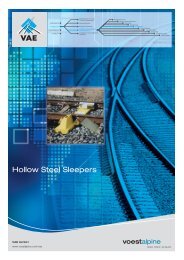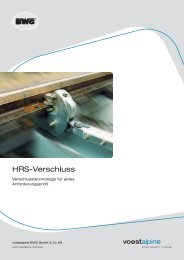HSE Report 2011 English - voestalpine
HSE Report 2011 English - voestalpine
HSE Report 2011 English - voestalpine
Create successful ePaper yourself
Turn your PDF publications into a flip-book with our unique Google optimized e-Paper software.
HEALTH, SAFETYandENVIRONMENT REPORT<strong>2011</strong><strong>voestalpine</strong>TubularsKINDBERGHealth, Safety andEnvironment PolicyStatistics of accidentsTrends of accident-indicesInternationalaccident-indicesEnvironmental balanceMaterial and PowerBalanceTrends ofInput/Output-indices<strong>voestalpine</strong> Tubulars GmbH & Co KGwww.vatubulars.com
Health, Safety and Environment <strong>Report</strong><strong>voestalpine</strong> Tubulars GmbH & Co KGAlpinestraße 178652 Kindberg-AumühlThe current Health Safety and Environment statement of the Kindberg located firm, <strong>voestalpine</strong>Tubulars GmbH & Co KG, specifies the company’s safety and environmental measures andstatistics for the year <strong>2011</strong>.
Management PoliticyOur Management System is based on the requirements of national andinternational standards or specifications such as DIN EN ISO 9001, APISpecification Q1, ÖNORM EN ISO 14001, ISO 50001 and BS OHSAS18001, and, at the same time, adheres to all statutory and legalrequirements.The focal points of the Management System are the criteria: quality;environment; energy; safety and health protection.Quality means to us:Flawless productsCustomer orientation and customer satisfactionFulfilment of customer demandsClear responsibilities and controlled processesFlexibility and reliable deliverySafety and health protection means to us:Safe work places, working equipment and installationsProtection of employees - creation of awarenessMinimisation of risk of accidents - accident prevention -accident avoidanceHealth promotion - order & cleanlinessEnvironment protection means to us:Conservation of resources - minimisation of emissionsAvoidance of impact on the environmentLegal complianceEnergy management means to us:Increase in energy efficiency - reduction of energy costUse of renewable types of energyLife-cycle management and sustainabilityThe basis for the effectiveness and the continuous improvementprocess of the Management System are the high qualifications andhighly developed personal responsibility of all employees as well asmodern and state-of-the-art installations.
Statistics of accidents <strong>2011</strong>Accident-Indices:In the year <strong>2011</strong>, we had1,631,023 production hours inthe Kindberg plant.Monthly average, <strong>voestalpine</strong>Tubulars employed908 blue collar workers.In the accident statistics, five key accident indicators are evaluated. Thefollowing key accident indicators relate to wage-earners only.2010 <strong>2011</strong>Accident rate Accidents per 100 employees 9.11 11.01Frequency of accidents Accidents per 1 million hours 55.42 61.31Gravity of accidents Absence time per accident 74.63 76.85Absence time of accidents Absence in % of working time 0.41 0.47Time debit due to accidents Hours per year and employee 6.80 8.46Accident rate – Absence time of accidents – Time debit due to accidents:The accident rate lies at11.01 accidents per100 employees in <strong>2011</strong>.The working hours lost toaccidents at workamounted to 0.47% of thetotal hours workedin <strong>2011</strong>.The working hours lost toaccidents at work were onaverage 8.46hours/year/employeein <strong>2011</strong>.Frequency of accidents – Gravity of accidents:The frequency ofaccidents amounted to61.31 accidentsper 1 million workinghours in <strong>2011</strong>.The average workingtime lost per accident(accident severity)amounted to76.85 hours in <strong>2011</strong>.
Industrial accidents <strong>2011</strong> according to the number of working days missed by theinjured employees:70605059Trifle accidents:up to 3 daysMinor accidents:4 to 19 days40302025Medium accidents:20 to 45 daysSerious accidents:more than 45 days108 80Trifle accidents Minor accidents Medium accidents Serious accidentsIn <strong>2011</strong>, a total of 100 accidents at work were reported, of which 25 werenegligeable, 59 minor, 8 medium and 8 were serious accidents.Mediumaccidents8%Seriousaccidents8%Trifle accidents25%More than half of the accidents (59%) were „minor accidents“ with arelated sick leave duration of between 4 to 19 days.Minor accidents59%Causes of accidents <strong>2011</strong> and injuries structured into parts of the body:1222146 2110516When analysing the causes of accidents, 24 of the 100 reported accidents (24%)relate to falls of the injured person and also 24 accidents (24%) were caused bycrushing or squeezing.39As regards injured parts of the body, the highest percentage concerned damageto hands (37 accidents), followed by 12 accidents concerned damage to the headand 11 accidents resulting in injuries to the torso.45
Trends of accident-indices:ACCIDENT RATECompared to 2010, theaccident rate in <strong>2011</strong>increased by 20.86%.GRAVITY OF ACCIDENTSCompared to 2010,the gravity of accidents in<strong>2011</strong> increased by 2.79%.TIME DEBIT DUETO ACCIDENTSCompared to 2010,the time debit due toaccidents in <strong>2011</strong>increased by 24.41%.
International accident-indices:In international accident statistics, TRIR and LTIF are evaluated.TRIRTotal RecordableIncident RateRatio of recordableaccidents to hoursworkedTRIR (<strong>2011</strong>) = 7.86LTIFLost Time InjuryFrequencyRatio of total hours lostto accidents at work tohours workedLTIF (<strong>2011</strong>) = 0.40%
Environmental balance <strong>2011</strong>The following table shows a summary of all environmental facts of <strong>voestalpine</strong>Tubulars from the Input-Output-Analysis (Material and Power Balance) for theyear <strong>2011</strong>.MATERIAL and POWER Balance <strong>2011</strong>Input:Output:Circulating goods (input in t) 479,522.428 Products and packaging (t) 428,018.836Raw materials (Steel ingots) 477,513.300 Products (steel pipes) 426,926.260Operating supplies 916.552 Product packaging 1,092.576Waste, scrap, recyclable material (t) 69,542.815Packaging for products 1,092.576 Recyclable waste 120.790Scrap 67,491.945Non-hazardous waste 503.470Hazardous waste 1,426.610Water (input in m³) 2,668,500 Wastewater (output in m³) 2,464,738Drinking water from well 33,482 Indirect sanitary water 29,632Industrial and cooling water 2,635,018 Direct wastewater 2,435,106Compressed air (input in m³) Exhaust air (emissions in t) 74,169.86Compressed air 71,919,800 Gas emissions 74,133.86Thereof CO 2 :Rest (CO, NO x , SO 2 , C tot , CH 4 ):74,111.5822.28Dust 5.57Solvent emissions 30.43Power supply Power consumption (MWh el ) 488,704.80Electricity (MWh el ) 76,949.50 Power consumption (electricity) 76,949.50Natural gas (m³) 36,953,231.00 Heating (gas) 410,180.86Fuel (litres) 156,904.00 Drive power (MWh el ) 1,574.44
Waste:We distinguish the following waste types: used materials, non-hazardous waste,hazardous waste and recyclable fractions.Waste type Waste fractions Total <strong>2011</strong> in tUsed materialsNon-hazardouswasteHazardous wasteGlass, metal packaging, organicwaste, cardboard packaging, lightfraction packagingConstruction rubble, commercialwaste, waste wood, filters andabsorbents, iron scale, thermal mix,furnace waste material a.o.Emulsions, oil-water mixtures, usedoils, oil sludge, operating suppliescontaminated with oil,phosphatizing sludge, aqueousconcentrates a.o.120.790503.4701,426.610Recyclable fractions Scale, scrap, shavings 67,491.945Total <strong>2011</strong>: 69,542.815All industrial waste iscollected separately, storedin accordance with existingregulations and handed overto duly authorized wastedisposal or recyclingcompanies!Waste water:After going through various stages of treatment, the process wastewater goesdirectly to the river Mürz. There are four different wastewater streams:Wastewater streamVolume<strong>2011</strong> in m 3Volume inm 3 per hourLimit in m 3per hourSeamless pipe plant 1,273,609 145.39 150CT plant 1,131,229 129.14 160Upsetting 20,824 2.38 8Phosphatizing 9,444 1.08 2Total <strong>2011</strong>: 2,435,106Wastewater treatment plants:Sedimentation for the seamless pipe plant wastewaterGravel filter for the wastewater from the CT plantNeutralisation for the wastewater from phosphatingFlotation for the wastewater from upsettingAdherence to the threshold values of waste water streams iscontrolled by both the company internal chemical laboratory andexternal testing institutes.Emissions:Waste water load <strong>2011</strong> kg per yearFiltratable substances 18,512.60COC 20,681.49Hydrocarbons 662.00Phosphorous 1,158.53Iron 391.16Ammonium 5.62Aluminium 17.91Nickel 1.79Manganese 3.12Chrome 2.08The majority of the emissions are caused by the combustion of natural gas forthermal processes and a small percentage by use of diesel vehicles.
Material Required quantity <strong>2011</strong> Gaseous emissionen in tNatural gas 36,953,231.00 m 3 73,719.48Diesel 155,785 litres 414.38Total <strong>2011</strong>: 74,133.86Of 74,111.58 tons ofgaseous emissions, themajor part (i.e. 99.97%)relates to CO 2 -emissionsPaints containing solvents and pure solvents cause <strong>2011</strong> solvent emissions in theamount of 30.43 tons.Energy:The energy consumption consists of the use of natural gas, electric energy andfuel.Energy Supply Required quantity <strong>2011</strong> Energy consumption in MWhElectricity 76,949.50 MWh el 76,949.50Natural gas 36,953,231.00 m 3 410,180.86Fuel 156,904.00 Liter 1,574.44Total <strong>2011</strong>: 488,704.80Material and Power Balance by the production of 1 ton steel pipe (<strong>2011</strong>):Power supply:- Electricity: 0.180 MWh- Natural gas: 86.556 m 3- Fuel: 0.367 l Water: 6.250 m 3- Drinking water from well: 0.078 m 3- Industrial and cooling water: 6.172 m 3Compressed air:168.459 m 3Emissions: 173.729 kg- CO2: 173.5934 kg- CO: 0.0043 kg- NOx : 0.0349 kg- SO2 : 0.0017 kg- Cges: 0.0113 kg- Dust: 0.013 kg- Solvent emissions: 0.071 kgSteel ingots: 1,118.491 gkgOperating supplies: 2.146 kg- Oil- Lubrications- Paint and lacquer- Solvents- Corrosives- Metal-workings agents- Phosphate means- Cleaning agentsPower consumption1.144 MWh- Electricity: 0.180 MWh- Natural gas: 0.960 MWh- Fuel: 0,004 MWhProduction:Heating – Rolling – Straightening – AdjustageUpsetting – Heat Treatment – Testing – ThreadingErhitzen - Walzen - Adjustieren -Wärmebehandeln Stauchen Coupling - production - Prüfen – Conserving -Gewindeschneiden -Waste water: 5.772 m 3- Indirect sanitary water: 0.069 m 3- Direct waste water: 5.703 m 3Recyclable: 158.088 kg- Späne, Zunder, SchrottNon-hazardous waste: 1.179 kgRecyclable waste: 0.282 kgHazardous waste: 3.341 kgSteel pipe: 1.000 kgPackaging: 2.559 kg
Trends of Input-Indices from 1998 to <strong>2011</strong>:The specific input and output values relate to the corresponding absolute valuesin proportion to the production volume.Trends of Output-Indices from 1998 to <strong>2011</strong>:
ImprintContent, design and layout:Management Systems DepartmentInnovations and InvestmentsContact:Harald KohlhoferT.+ 050304 23 366F.+ 050304 63 346harald.kohlhofer@vatubulars.com<strong>voestalpine</strong> Tubulars GmbH & Co KGAlpinestraße 178652 Kindberg-AumühlT.+43/50304/23-0F.+43/50304/63-0www.vatubulars.com



